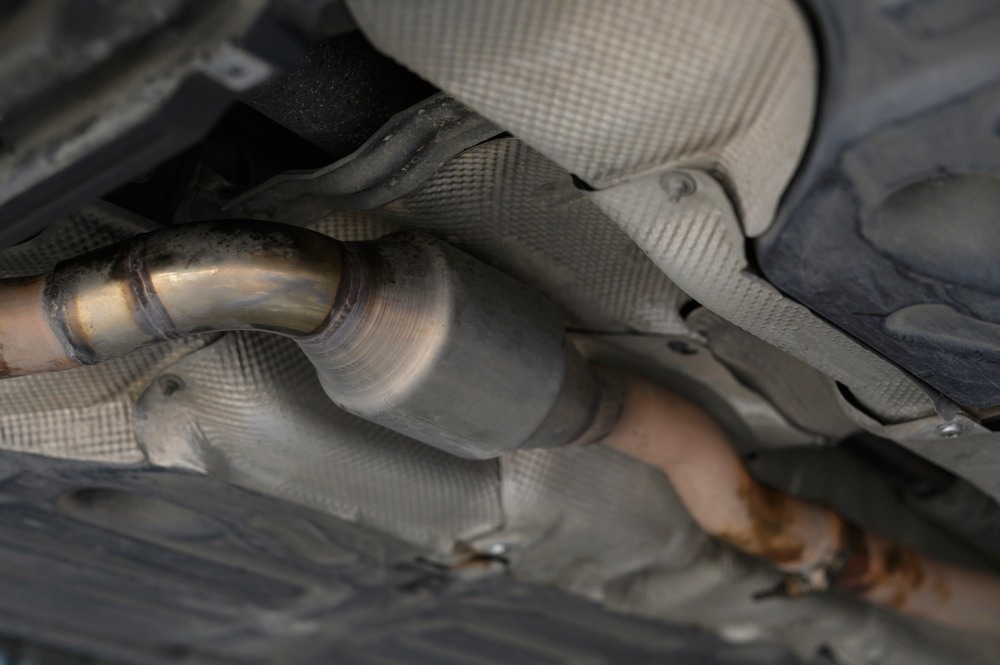A catalytic converter is a vehicle emissions control device that is used to convert toxic byproducts of combustion (occurring in the exhaust of an internal combustion engine) to less toxic substances by performing catalyzed chemical reactions. The reactions tend to vary depending on the type of catalyst installed. What materials are used in catalytic converters?

Image Credit: Setta Sornnoi/Shutterstock.com
This vehicle emission control device was invented by Eugene Houdry, a French mechanical engineer involved with catalytic oil refining. In 1973, former General Motors President Robert Stempel decided to begin their implementation in automobiles.
Since then, many scientists have been working on the development of the catalytic converter and as of 2010, they are mandatory on all cars in the US.
Although these devices are primarily used in exhaust systems in automobiles, they are also modified and used on trucks, buses, forklifts, mining equipment, generator sets, locomotives, motorcycles, airplanes, and other engine-fitted devices. They are also used on some wood stoves to control emissions.
What Materials are Used in Catalytic Converters?
The catalytic converter is made up of several materials. The catalyst core or substrate varies according to the vehicle. For example, when these devices are used in automobiles, the core is usually a ceramic monolith with a honeycomb structure.
When manufactured in large quantities, ceramic cores can be inexpensive. Metallic foil monoliths are made of an iron-chromium-aluminum combination and are used in some applications. Metallic cores are less expensive when manufactured for use in small production runs, such as in sportscars in which low back pressure and reliability under constant high load are essential. Both these materials are designed to provide a high surface area to support the catalyst washcoat.
The catalyst washcoat is a carrier for the catalytic converter materials, which is used to disperse the materials over a high surface area. Titanium dioxide, aluminum oxide, silicon dioxide, or a combination of silica and alumina can be used. The catalytic materials are suspended in the washcoat before application to the core. Washcoat materials have rough, irregular surfaces to increase surface area, which helps to maximize the catalytically active surface available to react with the engine exhaust.
The catalyst used in the converter is mostly a precious metal such as platinum, palladium, and rhodium. Platinum is used as a reduction catalyst and as an oxidation catalyst. Although platinum is a very active catalyst and widely used, it is very expensive and not suitable for all applications. Rhodium is used as a reduction catalyst, while palladium is used as an oxidation catalyst.
In some cases, cerium, iron, manganese, and nickel are also used. However, some companies forbid the use of some of these.
Different Variations of Catalytic Converter Materials
The key types of catalytic converters are listed below with a brief introduction:
- Two-way oxidation - The two-way oxidation instruments performs the two simultaneous tasks of oxidation of carbon monoxide to carbon dioxide and oxidation of hydrocarbons to carbon dioxide and water. This converter is widely used on diesel engines to reduce hydrocarbon and carbon monoxide emissions. However, this is no longer used in the U.S. and Canada due to their inability to control oxides of nitrogen.
- Three-way oxidation-reduction - The three-way oxidation-reduction devices are used in vehicle emission control systems in most parts of the world including the U.S. and Canada. The strict vehicle emission regulations have almost made it mandatory to use three-way converters on gasoline-powered vehicles. These converters have come to be recognized as one of the most important inventions in the history of automobiles. These perform three simultaneous tasks, namely, the reduction of nitrogen oxides to nitrogen and oxygen, oxidation of carbon monoxide to carbon dioxide, and oxidation of unburnt hydrocarbons to carbon dioxide and water.
- Diesel Oxidation Catalyst (DOC) - DOC's are most commonly used for compression ignition such as in diesel engines. This device uses oxygen in the exhaust gas stream to convert carbon monoxide to carbon dioxide and hydrocarbons to water and carbon dioxide. These converters are known to perform at 90% efficiency, wherein they manage to remove diesel odor and reduce visible particulates.
Environmental Impact
The catalytic converter was specifically invented to decrease harmful pollution caused by gases produced from the combustion of hydrocarbon-based fossil fuels in cars. Studies reveal that these devices can decrease hydrocarbon emissions by about almost 87%, carbon monoxide by 85%, and nitrous oxide by 62% during the expected life of a vehicle.
More from AZoM: How are Graphene Batteries Made?
References and Further Reading
- The 3-Way Catalytic Converter - arb
Disclaimer: The views expressed here are those of the author expressed in their private capacity and do not necessarily represent the views of AZoM.com Limited T/A AZoNetwork the owner and operator of this website. This disclaimer forms part of the Terms and conditions of use of this website.